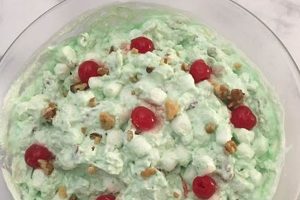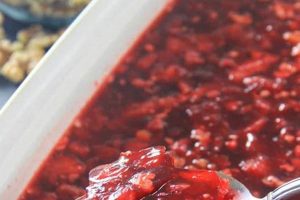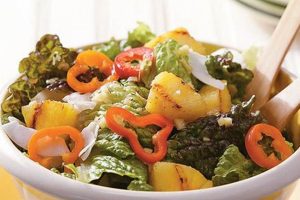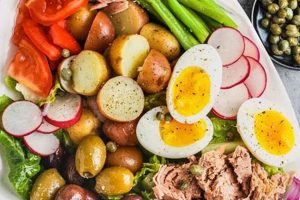A dish combining cooked noodles, typically of the pasta variety, with seasoned ground meat (often beef), classic taco toppings such as cheese, lettuce, tomatoes, onions, and a dressing reminiscent of taco sauce or a creamy, Southwestern-inspired dressing. Variations can include different protein choices, such as chicken or pork, and the addition of beans, corn, or other vegetables. The dish is generally served cold or at room temperature, making it a popular choice for picnics, potlucks, and quick meals.
The convenience and adaptability of this type of dish contribute to its popularity. It offers a customizable base, catering to diverse dietary preferences and ingredient availability. Its make-ahead nature makes it practical for busy lifestyles, while the flavorful combination of pasta, seasoned meat, and fresh toppings creates a satisfying and complete meal. The cold salad format also makes it a refreshing option for warmer weather. Historically, such dishes reflect a broader culinary trend of combining elements from different cuisines, often influenced by cultural exchange and the availability of ingredients.
Further exploration will cover variations in ingredients, dressings, preparation methods, and nutritional information relevant to this dish. Specific recipes will be provided, along with tips for successful preparation and serving suggestions.
Tips for a Successful Taco Noodle Salad
Optimizing ingredient selection and preparation techniques elevates this dish from simple to exceptional. Consider the following recommendations for a superior culinary experience.
Tip 1: Noodle Selection: Opt for sturdy pasta shapes that hold their form well when combined with other ingredients and dressings. Rotini, fusilli, and penne are excellent choices. Avoid delicate pasta types like angel hair or spaghetti, which can become mushy.
Tip 2: Meat Preparation: Utilize lean ground meat and ensure it’s thoroughly browned and seasoned. Draining excess grease prevents a heavy, oily salad. Consider incorporating spices like chili powder, cumin, and oregano for authentic taco flavor.
Tip 3: Dressing Choices: A creamy, Southwestern-inspired dressing complements the dish, but classic vinaigrette-style dressings with lime juice and cilantro offer a lighter alternative. Consider the overall flavor profile desired when selecting a dressing.
Tip 4: Vegetable Incorporation: Enhance flavor and texture by adding a variety of fresh vegetables. Diced tomatoes, shredded lettuce, chopped onions, and black beans or corn provide nutritional value and visual appeal.
Tip 5: Cheese Selection: Shredded cheddar or a Mexican blend are traditional choices, but crumbled cotija or queso fresco offer a more authentic touch. Consider experimenting with different cheese varieties to discover preferred flavor combinations.
Tip 6: Make-Ahead Strategy: Prepare components in advance and combine shortly before serving to prevent the salad from becoming soggy. Store the noodles, meat, vegetables, and dressing separately until ready to assemble.
Tip 7: Serving Suggestions: Serve chilled or at room temperature. Garnish with chopped cilantro, a dollop of sour cream or guacamole, or crushed tortilla chips for added texture and flavor.
Attention to these details ensures a well-balanced, flavorful, and visually appealing dish. Proper preparation and ingredient selection elevate the dining experience, creating a satisfying and memorable meal.
By following these recommendations, one can create a dish that is not only delicious but also adaptable to individual preferences and dietary needs. The following section provides specific recipes and further guidance on customization.
1. Ingredients
Ingredient selection is paramount to a successful taco noodle salad recipe. The interplay of flavors and textures contributes significantly to the overall culinary experience. Careful consideration of each component ensures a balanced and satisfying dish.
- Noodles:
The foundation of the salad, the noodles provide substance and texture. Sturdy shapes like rotini, fusilli, or penne hold their form well when combined with other ingredients and dressings. Overcooked noodles can result in a mushy texture, detracting from the overall enjoyment. Conversely, undercooked noodles offer an unpleasant, firm bite. Properly cooked, al dente pasta ensures a pleasant chewiness and complements the other elements.
- Protein:
Typically seasoned ground beef, the protein component adds savory depth. Lean ground beef is preferable to minimize excess grease. Alternatives include ground chicken, turkey, or even vegetarian substitutes like seasoned lentils or black beans. Proper seasoning enhances the protein’s flavor, integrating it seamlessly with the other ingredients.
- Vegetables:
Fresh vegetables contribute vibrant color, crisp texture, and essential nutrients. Common choices include chopped tomatoes, shredded lettuce, diced onions, and corn. These ingredients provide textural contrast to the noodles and protein, creating a balanced and refreshing salad. The choice of vegetables also allows for customization based on individual preferences and seasonal availability.
- Dressing:
The dressing ties the ingredients together, providing a cohesive flavor profile. Creamy, Southwestern-inspired dressings are popular, but lighter vinaigrette-style options offer a refreshing alternative. The dressing’s consistency and flavor should complement the other components without overpowering them. A well-balanced dressing enhances the overall taste experience.
The careful selection and preparation of these key ingredients contribute significantly to the final product. A harmonious blend of flavors and textures creates a delicious and satisfying taco noodle salad experience. Consideration of ingredient quality and freshness further elevates the dish, resulting in a truly memorable meal.
2. Preparation
Preparation significantly influences the final outcome of a taco noodle salad recipe. Methodical execution of each step ensures a harmonious blend of flavors and textures, elevating the dish beyond a simple assembly of ingredients. Careful attention to detail during preparation transforms individual components into a cohesive and satisfying culinary experience.
The process typically begins with cooking the noodles. Achieving the perfect al dente texture is crucial; overcooked noodles become mushy, while undercooked noodles remain unpleasantly firm. Properly cooked noodles provide a pleasant chewiness that complements the other ingredients. Simultaneously, the protein component, often ground beef, requires browning and seasoning. Thorough browning ensures optimal flavor development, while careful seasoning enhances the savory depth. Draining excess grease prevents a heavy, oily salad, contributing to a lighter, more refreshing final product.
Vegetable preparation contributes significantly to the salad’s texture and visual appeal. Chopping tomatoes, shredding lettuce, and dicing onions uniformly ensures even distribution throughout the salad and enhances the overall presentation. Pre-shredded cheese offers convenience, but freshly grated cheese often possesses a superior flavor and texture. Finally, the dressing, whether a creamy Southwestern-inspired blend or a lighter vinaigrette, requires thorough mixing to emulsify the ingredients and create a balanced flavor profile. Combining all components at the optimal time, typically just before serving, prevents the salad from becoming soggy and maintains the integrity of each ingredient.
Proper preparation directly impacts the overall quality of the taco noodle salad. Attention to seemingly minor details, such as noodle texture and ingredient uniformity, elevates the dish from a simple combination of ingredients to a carefully crafted culinary creation. Consistent execution of each preparatory step guarantees a consistently delicious and visually appealing final product.
3. Flavor Profiles
Flavor profiles play a crucial role in the overall enjoyment of a taco noodle salad recipe. A successful dish balances diverse tastes, creating a harmonious and satisfying culinary experience. Understanding these profiles allows for customization and adaptation based on individual preferences and dietary restrictions. Exploration of the key flavor components provides insight into the complexity and versatility of this dish.
- Savory Base:
The savory foundation typically comes from seasoned ground meat, often beef. The spices used, such as chili powder, cumin, and oregano, contribute significantly to the overall flavor profile. Proper browning of the meat enhances the savory notes, creating a rich and satisfying base for the salad. This savory element interacts with the other components, creating a balanced and complex flavor profile.
- Acidity:
Acidity provides a bright counterpoint to the savory base. Ingredients like tomatoes, lime juice in the dressing, or a touch of vinegar contribute a refreshing tang. This acidity balances the richness of the meat and dressing, preventing the salad from feeling heavy or overly rich. The level of acidity can be adjusted to individual preference, ranging from a subtle tang to a more pronounced sharpness.
- Creaminess/Freshness:
The choice of dressing significantly influences the overall flavor profile. Creamy dressings, often Southwestern-inspired, add richness and a smooth texture. Alternatively, lighter vinaigrette-style dressings provide a refreshing counterpoint. This element contributes to the overall mouthfeel and can be tailored to complement the other ingredients. Fresh vegetables like lettuce and cilantro further enhance the refreshing quality of the salad.
- Spiciness (Optional):
The level of spiciness can be adjusted to individual preferences. Jalapeos, a pinch of cayenne pepper, or a dash of hot sauce introduce a fiery kick. This element adds another layer of complexity and can be balanced with the other flavors. Careful control over the spiciness ensures a pleasant heat that enhances the overall enjoyment without overpowering the palate.
The interplay of these flavor profiles defines the character of a taco noodle salad. The careful balance of savory, acidic, creamy/fresh, and spicy elements creates a dynamic and enjoyable culinary experience. Understanding these components allows for informed choices regarding ingredient selection and customization, ensuring a dish tailored to individual preferences.
4. Dietary Adaptations
Dietary adaptations represent a crucial aspect of the taco noodle salad recipe, showcasing its versatility and inclusivity. Adapting the recipe to accommodate various dietary needs and preferences broadens its appeal and ensures accessibility for a wider range of individuals. Understanding these adaptations allows for customization without sacrificing flavor or satisfaction. Several key dietary considerations can be readily addressed within the framework of this dish.
Vegetarian/Vegan Adaptations: Replacing ground meat with plant-based protein sources such as lentils, black beans, or textured vegetable protein (TVP) creates a satisfying vegetarian or vegan version. Ensuring these substitutes are adequately seasoned maintains the savory depth of the dish. Additionally, using a vegan-friendly dressing and omitting any dairy-based cheese completes the adaptation. This approach allows individuals following plant-based diets to enjoy the flavors and textures of a taco noodle salad without compromising their dietary principles. For example, using seasoned black beans in place of ground beef provides a comparable protein content and a slightly smoky flavor that complements the other ingredients.
Gluten-Free Adaptations: Gluten-free pasta, readily available in various shapes and textures, seamlessly substitutes traditional wheat-based pasta. Ensuring the chosen dressing is also gluten-free caters to individuals with gluten sensitivities or celiac disease. This substitution allows for a comparable culinary experience without triggering adverse reactions. Selecting gluten-free corn or rice-based pasta maintains a similar texture and allows for the inclusion of individuals with gluten intolerance.
Dairy-Free Adaptations: Omitting cheese or substituting dairy-based cheese with vegan cheese alternatives caters to individuals with lactose intolerance or dairy allergies. Selecting a dairy-free dressing, often based on olive oil or avocado, further accommodates these dietary restrictions. These modifications ensure a satisfying and safe dining experience for those avoiding dairy products. For example, a creamy avocado-lime dressing provides a rich and flavorful alternative to traditional dairy-based dressings.
Adapting the taco noodle salad recipe to meet diverse dietary needs underscores its adaptability and inherent value. Understanding these modifications expands the dish’s accessibility, ensuring inclusivity and culinary enjoyment for a broader audience. The ability to cater to various dietary restrictions highlights the recipe’s flexibility and positions it as a versatile and valuable culinary option.
5. Serving Suggestions
Serving suggestions enhance the presentation and overall enjoyment of a taco noodle salad recipe. Consideration of these elements elevates the dish from a simple meal to a more complete and satisfying dining experience. Appropriate serving suggestions complement the flavors and textures of the salad, creating a harmonious and visually appealing presentation.
- Portioning and Plating:
Proper portioning ensures appropriate serving sizes and prevents food waste. Individual bowls or plates allow for customized portions and prevent the salad from becoming compressed or soggy. Thoughtful plating, considering visual appeal and ease of serving, enhances the dining experience. For example, arranging the salad on a bed of lettuce leaves adds visual interest and a fresh element.
- Garnishes:
Garnishes provide visual appeal and enhance the flavor profile. Chopped cilantro, a dollop of sour cream or guacamole, or crushed tortilla chips add contrasting textures and complementary flavors. Garnishes should be used judiciously to enhance the dish without overpowering the main components. For example, a sprinkle of chopped cilantro adds a fresh, herbaceous note, while crushed tortilla chips provide a satisfying crunch.
- Accompanying Dishes:
Complementary side dishes can create a more substantial and balanced meal. Serving the taco noodle salad alongside grilled corn on the cob, Spanish rice, or refried beans enhances the Southwestern theme. Consideration of flavor and texture compatibility ensures a cohesive and satisfying dining experience. For instance, the sweetness of grilled corn balances the savory notes of the salad, while the creamy texture of refried beans complements the crunch of the tortilla chips.
- Beverage Pairings:
Appropriate beverage pairings enhance the overall dining experience. Iced tea, margaritas, or Mexican beer complement the Southwestern flavors of the salad. The choice of beverage should consider the spice level and richness of the dish, creating a balanced and refreshing combination. For example, a light and refreshing margarita complements the spiciness of the salad, while a cold Mexican beer provides a crisp contrast to the creamy dressing.
Thoughtful serving suggestions contribute significantly to the enjoyment of a taco noodle salad recipe. From portioning and plating to garnishes and accompanying dishes, these elements elevate the dish beyond a simple meal to a more complete and satisfying dining experience. Careful consideration of these aspects ensures a visually appealing and flavorful presentation, enhancing the overall culinary experience.
6. Cultural Influences
Cultural influences play a significant role in shaping the concept and evolution of the taco noodle salad recipe. This dish exemplifies the fusion of culinary traditions, reflecting broader societal trends of cultural exchange and adaptation. Specifically, it represents a blending of Mexican-inspired flavors with the convenience and familiarity of pasta, a staple in many Western diets. This fusion reflects the increasing globalization of food and the adoption of ingredients and flavor profiles across cultures.
The dish’s popularity stems partly from the widespread accessibility of its core components. Pasta, ground meat, and common salad vegetables are readily available in most supermarkets, making the recipe easily adaptable to different regions and budgets. The adaptability of the recipe also allows for regional variations. For example, in the southwestern United States, the use of local chiles or specific types of beans might reflect regional culinary preferences. Similarly, the choice of pasta shape or the addition of specific vegetables might vary based on local availability and tradition. The widespread adoption of Mexican-inspired cuisine in many parts of the world has further contributed to the popularity and acceptance of this fusion dish.
Understanding the cultural influences behind the taco noodle salad provides valuable context for appreciating its evolution and significance. It demonstrates how culinary traditions adapt and evolve through cultural exchange and ingredient accessibility. This dish serves as a tangible example of how globalized food trends shape contemporary cuisine, reflecting the dynamic interplay of cultural influences on our dietary choices. The continued evolution of fusion cuisine like the taco noodle salad highlights the dynamic and interconnected nature of food culture in a globalized world.
Frequently Asked Questions
This section addresses common inquiries regarding taco noodle salad recipes, providing concise and informative responses to facilitate successful preparation and enjoyment.
Question 1: What type of pasta is best suited for this dish?
Sturdy pasta shapes like rotini, fusilli, and penne hold their form well when combined with other ingredients and dressings. Delicate pasta types should be avoided as they tend to become mushy.
Question 2: Can alternative proteins be used instead of ground beef?
Ground chicken, turkey, or plant-based protein sources such as lentils, black beans, or textured vegetable protein (TVP) offer suitable alternatives to ground beef. Adjust seasonings accordingly to complement the chosen protein.
Question 3: How can this recipe be adapted for gluten-free diets?
Substitute traditional wheat-based pasta with gluten-free alternatives made from rice, corn, or other gluten-free grains. Ensure all other ingredients, including the dressing, are also gluten-free.
Question 4: What are some recommended dressings for this salad?
Creamy, Southwestern-inspired dressings, French dressing, Catalina dressing, or lighter vinaigrette-style dressings with lime juice and cilantro complement the flavors of the salad. The choice depends on individual preference.
Question 5: Can this salad be prepared in advance?
Components can be prepared separately in advance and combined shortly before serving to prevent the salad from becoming soggy. Store noodles, meat, vegetables, and dressing separately until ready to assemble.
Question 6: How can the spiciness level be adjusted?
Adjusting the amount of chili powder or incorporating ingredients like jalapeos, cayenne pepper, or hot sauce allows for customization of the spiciness level. Start with small amounts and adjust to taste.
Careful consideration of these frequently asked questions ensures successful preparation and customization of taco noodle salad recipes. Addressing these common concerns empowers individuals to confidently create a dish tailored to individual preferences and dietary needs.
The following section provides a collection of curated recipes for exploration and further culinary inspiration.
Conclusion
Exploration of “taco noodle salad recipe” reveals a dish offering versatility, convenience, and adaptability. Key componentsnoodles, protein, vegetables, and dressingallow for extensive customization based on individual preferences and dietary needs. Understanding the interplay of flavors, textures, and cultural influences enhances appreciation for this fusion dish. Proper preparation techniques, from noodle cooking to ingredient selection, contribute significantly to the final product’s quality.
The dish represents a convergence of culinary traditions, reflecting broader trends in food globalization and ingredient accessibility. Continued experimentation with flavor profiles, dietary adaptations, and presentation styles ensures its enduring appeal. The “taco noodle salad recipe” provides a foundation for culinary creativity, offering a canvas for personalized interpretations and innovative adaptations within the evolving landscape of contemporary cuisine.






